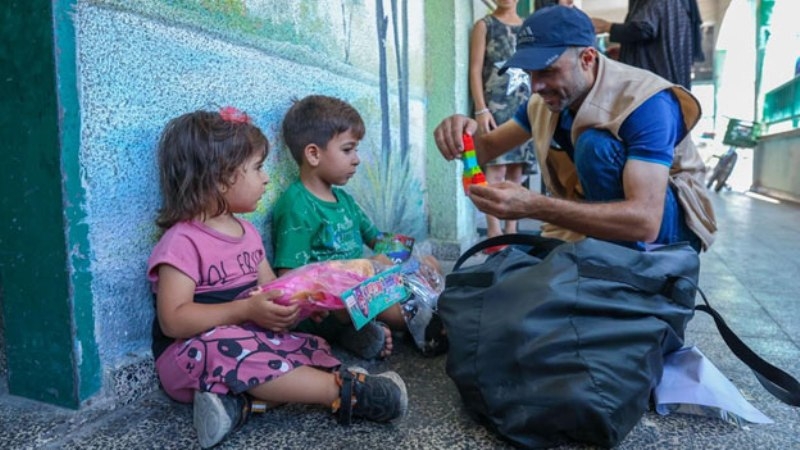- Hadi is no more, state mourning on Saturday: CA |
- Bangladesh capital market falls; weekly turnover lowest |
- Sharif Osman Hadi No More |
- Tarique Rahman to Return Home With Daughter on Dec 25 |
- ILO praises Bangladesh’s labour reforms, new milestones |
The Approaching Rainy Season Signals Trouble for Gaza

Children in a displacement shelter in the Northern Gaza Strip receiving psychological support kits. Credit- UNICEF-Media Clinic
By Oritro Karim
UNITED NATIONS, Oct 2 2024 (IPS) - As the humanitarian crisis in Gaza continues to grow more dire as a result of the Israel-Hamas war, concerns of diminishing public health are growing due to prolonged flooding. Repeated airstrikes and forced evacuations in recent weeks have pushed many displaced citizens to flooding hotspots. An influx of torrential rain has greatly exacerbated the failing sanitation system, increasing the risk of contracting waterborne diseases. Health experts fear that conditions will continue to worsen in the coming winter months.
A primary cause of concern for health officials is the large pooling of dirty water caused by the accumulation of torrential rain. This has created a suitable breeding ground for bacteria, viruses, and mosquitoes. Additionally, heavy flooding greatly increases chances of water contamination, which can cause diseases like cholera and Hepatitis A. The Global WASH Cluster adds that increased flooding raises the likelihood of citizens experiencing snakebites. It is also stated that mental health among displaced persons is expected to worsen as living conditions grow more harsh.
In a press release issued on 30 September from the United Nations (UN), Spokesperson for the Secretary-General, Stéphane Dujarric, stated that 215 learning facilities sheltering approximately 34,000 children are predicted to be severely damaged by flooding. Hundreds of thousands of Gazans are projected to be internally displaced in the coming rainy season.
Last year’s rainy season was described as “catastrophic” by health officials. Ajith Sunghay, the head of Office of the United Nations High Commissioner for Human Rights (OHCHR) for the Occupied Palestinian Territory, described the sanitation levels in Gaza last year as “uninhabitable”, adding that most of the displaced persons don’t have access to clothes or blankets to stay warm. Sunghay emphasizes the harsh conditions of the winter months in Gaza by saying that he fears that many civilians will die and that this time of year is “entirely predictable”.
The healthcare system in Gaza is currently not properly equipped to handle the influx of sick and injured people that are predicted to come in the final quarter of 2024. According to OCHA, there are currently only 17 hospitals that remain partially functional, with all of them facing significant shortages in fuel, medicines, and supplies.
It is estimated that about 1.4 million people did not receive their monthly food rations in September due to a lack of supplies. Currently, humanitarian organizations are in the process of delivering 600,000 daily meals despite continued access challenges. Additionally, it is estimated by the World Bank that as of now, 100 percent of Gazans are living in poverty.
The Office for the Coordination of Human Affairs (OCHA) warns that further restrictions of humanitarian aid in critically vulnerable areas will greatly aggravate declining public health as aid organizations won’t be able to prepare for the upcoming rainy season. The UN and its affiliated organizations have developed a winterization plan in an effort to mitigate the harsh living conditions observed in Gaza for the final quarter of the year. This plan is targeted to assist over 850,000 individuals in almost 50 of the most flood-affected areas.
“It requires $242 million to improve shelter conditions; provide warm clothing and blankets; and redirect floodwaters away from critical infrastructure and dumping sites, among other interventions”, stated Dujarric. However, OCHA acknowledges that these efforts will not be successful if restrictions aren’t lifted, allowing for easier access between supply warehouses and displacement shelters. The UN urges further donor contributions as living conditions are projected to grow harsher in the coming months.
IPS UN Bureau Report

